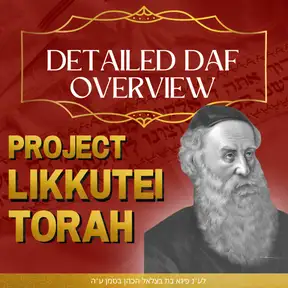
Torah Ohr Daf 37 2-רני ושמחי בת ציון
Summary
With Rabbi Dovid Leib Shmerling from Melbourne, AUQ1- What is the inner meaning of Rani V’Simchi?Q2- What is its relationship to Chanukah?“Ivdu es Hashem b’simcha, bayu lifanav b’raninah”. The Zohar says “simcha” corresponds Tzafrah (day), and “ranenah” to Rimsah (night). We need to understand both of these ideas. “Raninah” The avodah of the Malachim (and all of creation) is that of Raninah, song and praise. These express the yearnings of the Malachim to lose themselves in Hashem (Ratzu). Now, the desire to come close to Hashem implies that one is distant. When one is in the presence of that which he desires, one no longer strives towards anything. This is even more so when the object of one’s desire (here, Or Ein Sof) causes the obliteration of the self (Bittul).The Malachim are always trying to get closer to OE”S, are always “singing”, because they only relate to Malchus, or more generally, Seder Hishtalshelus, which provides them with there existence but which is not Hashem Himself. (This is the meaning of “v’tzikascha yrianenu”: Tzedek=Malchus, which is the way OE”S sustains all of creation. And yet this is only an external expression of Hashem, “zecher rav tuvcha…”.)This is the meaning of Rimsa, and its relation to Ranena: Malchus=Olam=Helem=Night. The Malachim sing because they wish to escape the “night”, the expression of Hashem which hides His true being.In our avodah, this means the Ahavah to Hashem which leads to the desire to escape the body and the NH”B. This is expressed in “Boruch shem…”. The Malachim only serve Hashem in this way. However, for us, this is only the first stage in avodah. “Simcha”The second stage is that we draw Elokus into this world (Shuv). The simcha that we have is the result of the revelation of Elokus in the world through Torah and Mitzvos. Even though on our own, we can only reach Tzedek/Malchus, Hashem, who is equally above all, invested His Essence into Torah and Mitzvos. “ivdu es Hashem b’simcha”: Hashem= Ein Sof B”H with Simcha shel Mitzvah (and the Mitzvah leads to Simcha). Now we can understand the meaning of “rani v’simchi bas tzion”:“yimloch Hashem lioam elokayich tzion, lidor v’dor…”: in order to draw Elokus into the world (yimloch.. lolam..dor v’dor), we need to perform Torah and Mitzvos, which are symbols/physical manifestations of different expressions of Elokus, and which draw those same expressions into the world. (This is also the case by Brachos HaMitzvos: Bracha= hamavrich gefen=Hamshacha ). When there is ISADL”S, which allows for the revelation caused by Mitzvos to be apparent, we are also referred to as Tzion. But when there is no ISADL”S, we are called Bas Tzion (bas=mekabel w/o mashpia). The example for this can be seen in davening: only through the avodah of PSD”Z (Rinah, ISADL”S) do we reach the Bittul of Krias Shema (Simcha). Of course, mitzvot have an effect even without our love/bittul. But not as much as they would have if we also had those emotions. However, at the time of Moshiach, even Bas will reach reach Simcha, through a even higher level of ISADL”E.Neiros Chanukah represent some kind of ISADL”S, Raninah.Zman and Makom are creations, from Malchus.Malachim only serve in a way of Ratzu. Jews have the additional ability to cause Shuv.We reach the bittul of Krias Shemah only through the Avodah of PSD”Z.Mitzvot always draw down Elokus, but so on a deeper level when they are done with emotion. Support the showWith Rabbi Dovid Leib Shmerling from Melbourne, AU
Q1- What is the inner meaning of Rani V’Simchi?
Q1- What is the inner meaning of Rani V’Simchi?
Q2- What is its relationship to Chanukah?“Ivdu es Hashem b’simcha, bayu lifanav b’raninah”. The Zohar says “simcha” corresponds Tzafrah (day), and “ranenah” to Rimsah (night). We need to understand both of these ideas.
“Raninah” The avodah of the Malachim (and all of creation) is that of Raninah, song and praise. These express the yearnings of the Malachim to lose themselves in Hashem (Ratzu).
“Raninah” The avodah of the Malachim (and all of creation) is that of Raninah, song and praise. These express the yearnings of the Malachim to lose themselves in Hashem (Ratzu).
- Now, the desire to come close to Hashem implies that one is distant. When one is in the presence of that which he desires, one no longer strives towards anything. This is even more so when the object of one’s desire (here, Or Ein Sof) causes the obliteration of the self (Bittul).
- The Malachim are always trying to get closer to OE”S, are always “singing”, because they only relate to Malchus, or more generally, Seder Hishtalshelus, which provides them with there existence but which is not Hashem Himself. (This is the meaning of “v’tzikascha yrianenu”: Tzedek=Malchus, which is the way OE”S sustains all of creation. And yet this is only an external expression of Hashem, “zecher rav tuvcha…”.)
- This is the meaning of Rimsa, and its relation to Ranena: Malchus=Olam=Helem=Night. The Malachim sing because they wish to escape the “night”, the expression of Hashem which hides His true being.
- In our avodah, this means the Ahavah to Hashem which leads to the desire to escape the body and the NH”B. This is expressed in “Boruch shem…”. The Malachim only serve Hashem in this way. However, for us, this is only the first stage in avodah.
- “Simcha”
- The second stage is that we draw Elokus into this world (Shuv). The simcha that we have is the result of the revelation of Elokus in the world through Torah and Mitzvos. Even though on our own, we can only reach Tzedek/Malchus, Hashem, who is equally above all, invested His Essence into Torah and Mitzvos.
- “ivdu es Hashem b’simcha”: Hashem= Ein Sof B”H with Simcha shel Mitzvah (and the Mitzvah leads to Simcha).
- Now we can understand the meaning of “rani v’simchi bas tzion”:
- “yimloch Hashem lioam elokayich tzion, lidor v’dor…”: in order to draw Elokus into the world (yimloch.. lolam..dor v’dor), we need to perform Torah and Mitzvos, which are symbols/physical manifestations of different expressions of Elokus, and which draw those same expressions into the world. (This is also the case by Brachos HaMitzvos: Bracha= hamavrich gefen=Hamshacha ).
- When there is ISADL”S, which allows for the revelation caused by Mitzvos to be apparent, we are also referred to as Tzion. But when there is no ISADL”S, we are called Bas Tzion (bas=mekabel w/o mashpia). The example for this can be seen in davening: only through the avodah of PSD”Z (Rinah, ISADL”S) do we reach the Bittul of Krias Shema (Simcha).
- Of course, mitzvot have an effect even without our love/bittul. But not as much as they would have if we also had those emotions.
- However, at the time of Moshiach, even Bas will reach reach Simcha, through a even higher level of ISADL”E.
- Neiros Chanukah represent some kind of ISADL”S, Raninah.
- Zman and Makom are creations, from Malchus.
- Malachim only serve in a way of Ratzu. Jews have the additional ability to cause Shuv.
- We reach the bittul of Krias Shemah only through the Avodah of PSD”Z.
- Mitzvot always draw down Elokus, but so on a deeper level when they are done with emotion.
